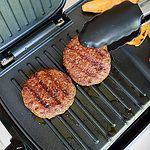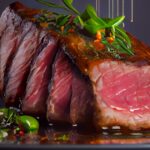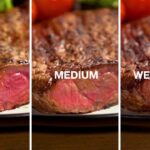How To Cook Steak on George Foreman Grill (Temperature, Cuts, Time)
If you love the convenience of indoor grilling but want to achieve that smoky, char-grilled flavor, a George Foreman grill is a great option. In this comprehensive guide, we’ll cover everything you need to know about choosing the right cut of steak, using different types of grills, and perfecting the cooking process to get delicious, juicy results every time. Whether you’re a beginner cook or a seasoned pro, this step-by-step guide will help you cook the perfect steak on your George Foreman grill.
Choose the right cut of steak for your George Foreman Grill
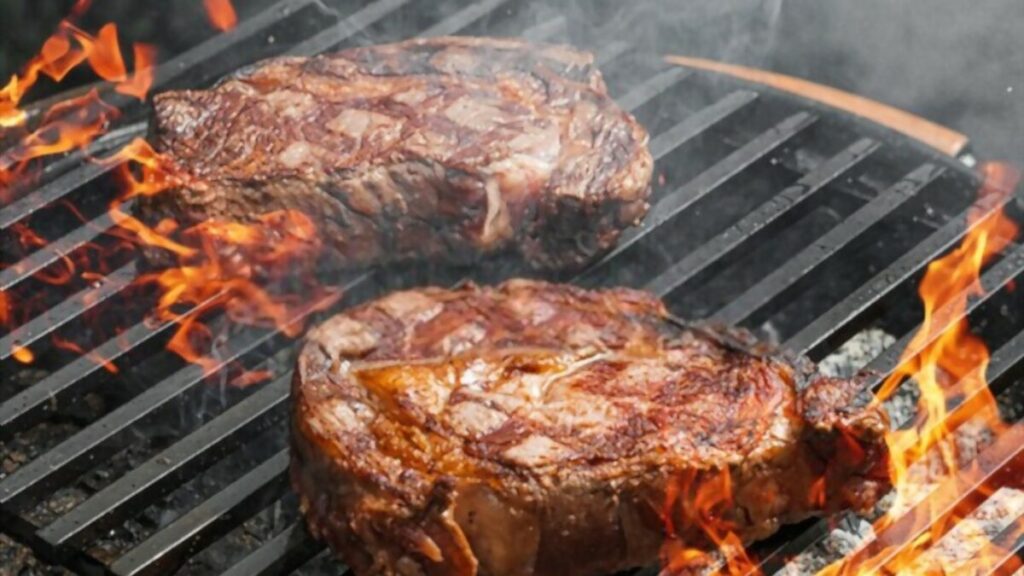
When it comes to grilling steak, the cut of meat you choose can make a big difference in the final result. Here are some of the most popular cuts of steak, along with their characteristics and best uses:
- Ribeye steak: This cut has lots of marbling, or fat running through the meat, which makes it extra juicy and flavorful. Ribeye is a good choice for grilling, as the fat will melt and baste the meat as it cooks.
- Sirloin steak: Sirloin is a leaner cut of steak, with less marbling than ribeye. It can be a bit tougher than some other cuts, but it’s still a good choice for grilling. Look for a thicker sirloin steak, as it will be more tender and easier to cook to your desired level of doneness.
- New York strip steak: This cut is similar to sirloin in terms of its leanness and lack of marbling. It’s a bit more tender than sirloin, and has a bold, beefy flavor that makes it a popular choice for grilling.
- Filet mignon: This ultra-tender cut comes from the smaller end of the tenderloin, and is known for its delicate texture and mild flavor. Filet mignon is best cooked to medium-rare or medium doneness, as it can become dry and tough if overcooked.
- Skirt steak: This thin, flavorful cut comes from the diaphragm of the cow, and is known for its strong beefy flavor. It’s a bit tougher than some other cuts, so it’s best cooked to medium-rare or medium doneness. Skirt steak is often used for fajitas or other Mexican dishes.
When choosing a cut of steak for your George Foreman grill, keep in mind that the cooking time and desired doneness will vary depending on the thickness of the steak. In general, a thicker steak will take longer to cook and can be cooked to a higher level of doneness without drying out. A thin steak, on the other hand, will cook quickly and should be removed from the grill as soon as it reaches the desired level of doneness.
Learn about the different types of grills and their features
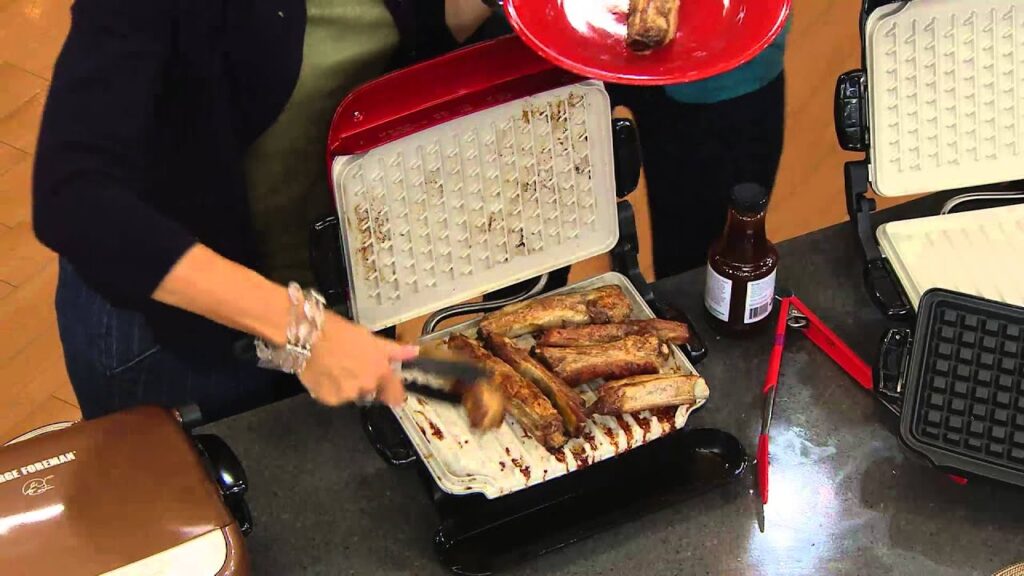
There are several different types of grills that you can use to cook steak on a George Foreman grill, each with its own set of features and benefits. Here’s a brief overview of the most common types of grills:
- Outdoor grill: This is the classic option for grilling steak, and is perfect for those who have a backyard or patio with enough space to set up a grill. Outdoor grills come in several different types, including gas grills, charcoal grills, and wood-fired grills. One of the main advantages of outdoor grillsis that they allow you to get that smoky, char-grilled flavor that many people love. The main disadvantage is that they require you to be outside, which may not be practical in all weather conditions.
- Indoor electric grill: If you don’t have access to an outdoor grill, an indoor electric grill is a great alternative. These grills use electricity to heat a cooking surface, and are designed to be used indoors. One of the main advantages of indoor electric grills is that they are convenient and easy to use – just plug them in and start grilling. They also tend to be relatively easy to clean, as many of them have removable, non-stick grill plates. The main disadvantage is that they may not be able to achieve the same level of char and smoky flavor as an outdoor grill.
- Charcoal grill: A charcoal grill uses charcoal briquettes as a fuel source, and is known for its ability to impart a smoky flavor to grilled foods. Charcoal grills are typically more portable than gas grills, which makes them a good choice for tailgating or camping. The main disadvantage of charcoal grills is that they can be messy to use and take longer to heat up than gas grills.
- Indoor contact grill: An indoor contact grill is a type of electric grill that has two heated cooking surfaces that press together, similar to a panini maker. These grills are great for cooking steak, as the dual contact allows for faster cooking and more even heat distribution. They are also typically easy to clean, as many of them have non-stick grill plates. The main disadvantage of indoor contact grills is that they may not be able to achieve the same level of char and smoky flavor as an outdoor grill.
- Panini maker: A panini maker is a type of indoor contact grill that is specifically designed for making paninis. While it can be used for grilling steak, it may not be the best choice, as the narrow cooking surface may not be able to accommodate larger cuts of meat.
When choosing a grill for cooking steak on a George Foreman grill, consider the features that are most important to you. Some grills, such as indoor electric grills, may have temperature controls and indicator lights to help you achieve the desired level of doneness. Others, such as outdoor grills, may have a heating element that allows you to adjust the level of heat to suit your needs.
Step-by-step guide for cooking the perfect steak on your George Foreman grill
Now that you’ve chosen the right cut of steak and the perfect grill, it’s time to get cooking! Here’s a step-by-step guide to help you achieve delicious, juicy results every time:
- Preheat the grill: Before you start grilling, make sure to preheat the grill to the desired temperature. This will help ensure that the steak cooks evenly and achieves the desired level of doneness.
- Prepare the steak: Take the steak out of the refrigerator and let it come to room temperature before grilling. This will help the steak cook more evenly and reduce the risk of it drying out. If you like, you can also coat the steak in a thin layer of olive oil, which will help it achieve a nice sear and prevent it from sticking to the grill.
- Season the steak: Before grilling, season the steak with a pinch of black pepper or your favorite seasoning blend. This will help enhance the flavor of the steak and give it a nice crust when it’s cooked.
- Place the steak on the grill: Once the grill is preheated, place the steak on the cooking surfaceand close the lid. If you’re using an indoor electric grill or an indoor contact grill, make sure to use a non-stick cooking spray to prevent the steak from sticking to the grill plates.
- Cook the steak to the desired level of doneness: The cooking time for steak on a George Foreman grill will depend on the thickness of the steak and the desired level of doneness. As a general rule, a thinner steak (1/2 inch or less) will cook in 2-3 minutes per side for medium-rare, 3-4 minutes per side for medium, and 4-5 minutes per side for well-done. A thicker steak (more than 1/2 inch) will take longer to cook – aim for 4-7 minutes per side for medium-rare, 5-8 minutes per side for medium, and 7-10 minutes per side for well-done.
- Check the internal temperature: To ensure that your steak is cooked to the desired level of doneness, it’s a good idea to use a digital meat thermometer to check the internal temperature. For medium-rare, aim for an internal temperature of 135-140°F. For medium, aim for an internal temperature of 145-150°F. For well-done, aim for an internal temperature of 155-160°F.
- Remove the steak from the grill: Once the steak has reached the desired level of doneness, remove it from the grill and let it rest for a few minutes before slicing and serving. This will allow the juices to redistribute throughout the steak and make it more tender and juicy.
- Serve the steak: When the steak is ready to be served, slice it against the grain into thin strips and serve it with your favorite sides. Grilled vegetables, roasted potatoes, or a simple salad are all great options.
By following these simple steps, you can achieve delicious, juicy results every time you cook steak on a George Foreman grill. Whether you’re grilling for a special occasion or just want a quick and easy dinner option, a perfectly grilled steak is a great way to impress your friends and family.
Tips for achieving the best results when grilling steak on a George Foreman grill
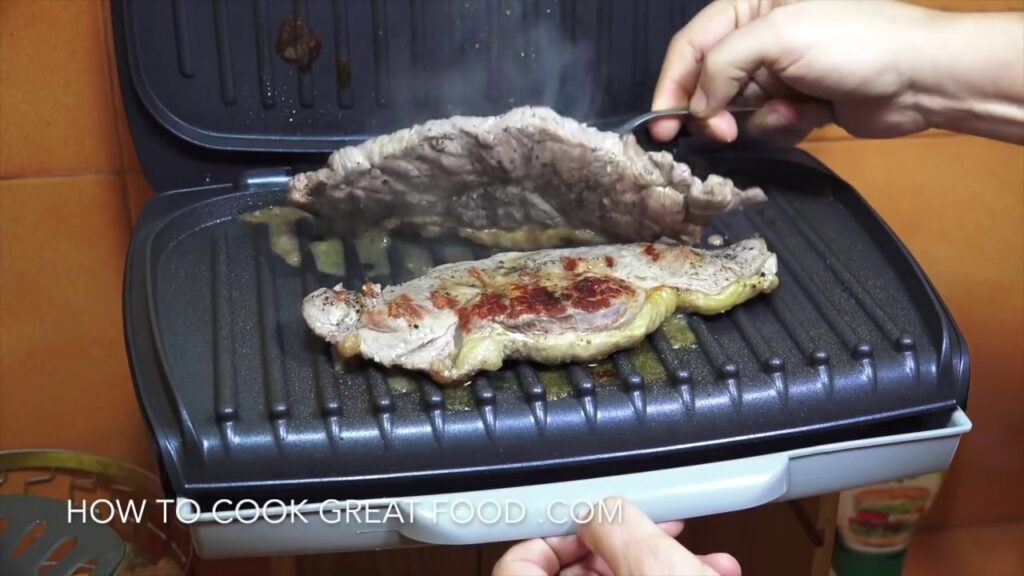
While grilling steak on a George Foreman grill is relatively easy, there are a few tips that can help you achieve the best possible results:
- Use a meat tenderizer: If you’re using a tougher cut of steak, such as sirloin or skirt steak, consider using a meat tenderizer to help soften the meat and make it more tender. There are several different types of meat tenderizers available, including mallets, rolling pins, and chemical tenderizers.
- Trim excess fat: To prevent the steak from becoming greasy or fatty, be sure to trim away any excess fat before grilling. This will help the steak cook more evenly and reduce the risk of flare-ups on the grill.
- Use a liquid smoke: If you want to add a smoky flavor to your steak but don’t have access to an outdoor grill, consider using a liquid smoke to achieve a similar effect. Simply brush the steak with a mixture of liquid smoke and Worcestershire sauce before grilling, and you’ll get a smoky, char-grilled flavor without having to go outside.
- Use a clean cutting board: When it’s time to slice and serve the steak, be sure to use a clean cutting board to prevent the risk of bacterial contamination. Wash the cutting board with warm soapy water before and after use, and be sure to use a separate cutting board for raw and cooked meats to prevent cross-contamination.
- Let the steak rest: After grilling, it’s important to let the steak rest for a few minutes before slicing and serving. This will allow the juices to redistribute throughout the steak, making it more tender and juicy. As a general rule, aim for a rest time of about 5-10 minutes for a medium-sized steak.
- Slice against the grain: When it comes time to slice the steak, be sure to slice it against the grain. This means cutting the steak perpendicular to the direction of the muscle fibers. Slicing against the grain will help the steak be more tender and easier to chew.
By following these tips, you can achieve the best possible results when grilling steak on a George Foreman grill. Whether you’re a beginner cook or a seasoned pro, these simple techniques will help you cook a delicious, juicy steak every time.
Cooking time and temperature settings for different levels of doneness
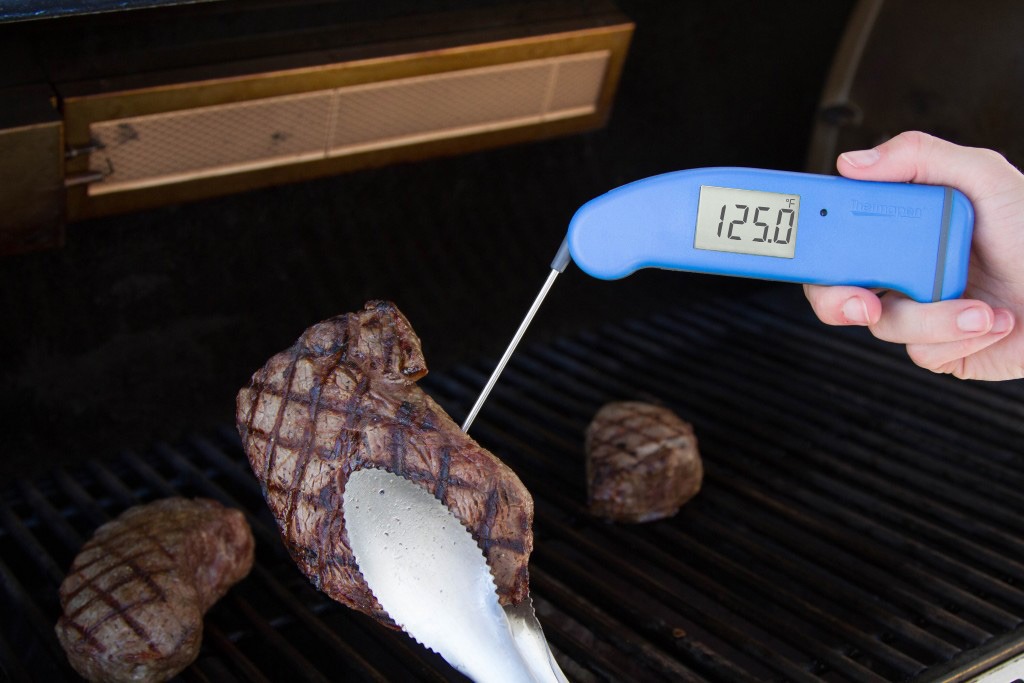
One of the keys to grilling a delicious steak on a George Foreman grill is getting the cook time and temperature settings just right. The cooking time and temperature will depend on the thickness of the steak and the desired level of doneness. Here are some general guidelines for achieving medium-rare, medium, and well-done steaks on a George Foreman grill:
- For a medium-rare steak: Aim for a cook time of 4-7 minutes per side on a high setting (around 400-450°F). Use the temperature control and indicator light on your grill to monitor the internal temperature of the steak and make sure it stays within the desired range (135-140°F).
- For a medium steak: Aim for a cook time of 5-8 minutes per side on a medium-high setting (around 350-400°F). Use the temperature control and indicator light to monitor the internal temperature of the steak and make sure it stays within the desired range (145-150°F).
- For a well-done steak: Aim for a cook time of 7-10 minutes per side on a medium setting (around 300-350°F). Use the temperature control and indicator light to monitor the internal temperature of the steak and make sure it stays within the desired range (155-160°F).
Keep in mind that these are just general guidelines, and the actual cooking time and temperature may vary depending on the thickness of the steak and the type of grill you are using. To ensure the best possible results, it’s a good idea to use a digital meat thermometer to check the internal temperature of the steak as it cooks.
Grilling thin and thick steaks on a George Foreman grill
When it comes to grilling steak on a George Foreman grill, the thickness of the steak can make a big difference in the final result. Here are some tips for grilling thin and thick steaks on a George Foreman grill:
- For thin steaks (1/2 inch or less): Thin steaks are best cooked to medium-rare or medium doneness, as they can dry out and become tough if overcooked. To grill a thin steak on a George Foreman grill, aim for a cook time of 2-3 minutes per side on a high setting (around 400-450°F) for medium-rare, or 3-4 minutes per side on a medium-high setting (around 350-400°F) for medium. Use a non-stick surface and a cooking spray to prevent the steak from sticking to the grill plates.
- For thick steaks (more than 1/2 inch): Thick steaks are more forgiving than thin steaksand can be cooked to a wider range of doneness levels. To grill a thick steak on a George Foreman grill, aim for a cook time of 4-7 minutes per side on a high setting (around 400-450°F) for medium-rare, 5-8 minutes per side on a medium-high setting (around 350-400°F) for medium, or 7-10 minutes per side on a medium setting (around 300-350°F) for well-done. As with thin steaks, it’s a good idea to use a non-stick surface and a cooking spray to prevent the steak from sticking to the grill plates.
One important thing to keep in mind when grilling thick steaks is to let the fat melt and drip away from the steak as it cooks. To do this, place the steak on the front of the grill (closest to the drip tray) and close the lid. The heat from the grill will cause the fat to melt and drip away from the steak, which will help it cook more evenly and prevent it from becoming greasy.
Grilling a healthier version of a grilled steak
While grilled steak can be a delicious and satisfying meal, it’s not always the healthiest option. If you’re looking to enjoy a grilled steak while still maintaining a healthy diet, there are a few things you can do to make the meal a little bit healthier:
- Trim excess fat: To reduce the fat content of your steak, be sure to trim away any excess fat before grilling. This will help the steak cook more evenly and reduce the risk of flare-ups on the grill.
- Use a leaner cut of meat: Choose a leaner cut of meat, such as filet mignon or sirloin, to reduce the overall fat content of the steak. These cuts tend to be lower in fat than other cuts, such as ribeye or new york strip.
- Grill boneless products: Boneless products, such as chicken breasts or turkey cutlets, are a great option for a healthier grilled steak. They are typically lower in fat than bone-in cuts and are easy to grill on a George Foreman grill.
- Use a marinade: To add flavor to your steak without adding extra fat, try using a marinade made with low-fat ingredients such as balsamic vinegar or Worcestershire sauce. These marinades will help to tenderize the meat and add flavor, without adding unnecessary calories.
By following these tips, you can enjoy a delicious, grilled steak while still maintaining a healthy diet.
More George Foreman Grill Recipes and Resource
How To Cook Burgers On a George Foreman Grill
How Long To Cook Steak on George Foreman Grill (Medium, Rare, Well-done)
Timing to Grill Perfect Chicken Breast on a George Foreman Grill
Grilling the Perfect Steak on a George Foreman Grill – Timing is Everything!
Cooking Pork Chops on a George Foreman Grill: A Step-by-Step Guide
How to Clean a George Foreman Indoor Outdoor Grill: A Chef’s Guide
How to Use George Foreman Grill: Tips and Techniques from a Chef
This article is a part of The Ultimate Steak Cookbook, our ever-growing mini encyclopedia on techniques for delicious steak recipes. Please bookmark and return. There will be a lot of useful information for you.

Shara @The Bird BBQ
Shara loves to experiment with different flavors and techniques when it comes to BBQ. She has been perfecting her craft for years and loves hosting backyard BBQs with friends & family. She often comes up with creative recipes that her guests rave about.

